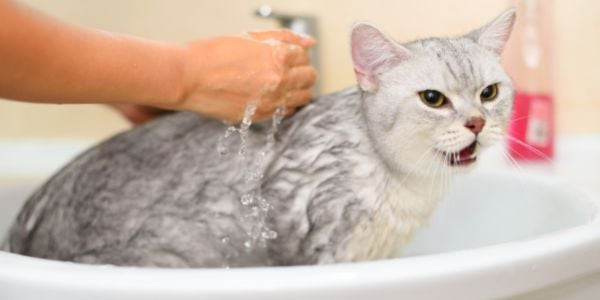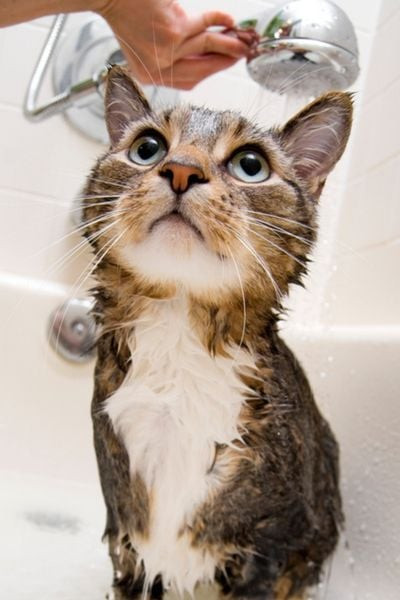Does the mere thought of bathing your feline friend send shivers down your spine? Are you mentally preparing for a battle of claws and hisses, stocking up on bandages and antiseptic cream in anticipation? Whether you’re a seasoned pro at Cat Baths or facing the daunting task for the very first time, the idea can be, let’s face it, a little intimidating.
Most cats are not fans of being submerged in water. From a cat’s perspective, a bath is far from a spa day. They are meticulous groomers, after all, spending a significant portion of their day keeping their coats pristine.
So, how do you determine if your cat actually needs a bath? And more importantly, how can you navigate bath time without turning your bathroom into a war zone? Relax! We’re here to guide you through everything you need to know, from the essentials to expert tips, to make cat bath time less stressful for both you and your beloved pet.
Do Cats Really Need Baths? Understanding Feline Hygiene
Generally speaking, no, cats are naturally clean animals and don’t require regular baths from their human companions. They are incredibly efficient self-groomers. In fact, water-soaked fur can feel unpleasant to a cat, an unwelcome sensation they instinctively want to eliminate. They are typically very effective at maintaining their cleanliness independently.
However, there are certain situations where your cat might benefit from, or even require, a traditional bath:
- Limited Mobility: As cats age (typically 8 years and older), they become more susceptible to joint pain, arthritis, and other conditions that reduce their flexibility. If a senior cat can no longer comfortably reach certain areas of their body, they may need assistance with bathing to stay clean.
- Emergency Situations & Safety: If your cat has come into contact with a hazardous substance, a bath is crucial. This includes chemicals, oils, or even toxic pollen like that from true lilies. Ingesting these substances through grooming can be dangerous. Similarly, if you’ve mistakenly applied dog flea medication to your cat (containing pyrethroids), an immediate bath is necessary, as these are highly toxic to cats. In such cases, veterinary attention is also essential.
- Persistent Messes: Sometimes, despite their best efforts, cats can get into situations that result in a very dirty rear end that goes beyond a simple wipe.
- Long-Haired Cat Coat Care: Long-haired cat breeds are prone to developing mats in their fur. While regular daily brushing and sanitary trims can significantly reduce the need, baths can sometimes be necessary to manage and prevent painful matting.
- Lethargy and Low Energy: If your cat is experiencing lethargy due to age or underlying health issues, self-grooming might become less of a priority. In these instances, they may need help staying clean.
- Wound Management: Your veterinarian might recommend bathing as part of a treatment plan for a cat’s injury. It is crucial to strictly adhere to your vet’s instructions in these situations.
- Skin Conditions: Cats suffering from allergies, fleas, ringworm, or other skin conditions may require medicated baths or special shampoos as part of their treatment. Again, always follow your veterinarian’s specific guidance.
- Obesity: Overweight cats, similar to senior cats with mobility issues, may struggle to reach all areas of their body for effective self-grooming.
 bathing a large grey cat in the sink
bathing a large grey cat in the sink
Alt text: A close-up image of a fluffy grey cat calmly being bathed in a kitchen sink, showcasing a positive cat bath experience.
Creating a Calm Cat Bath Experience: Building Comfort and Trust
While some rare cats might actually enjoy playing in water, the majority are not naturally inclined to take baths. If you happen to have a water-loving feline, consider yourself very fortunate! Even then, a gradual introduction to the bathing routine is still a wise approach.
If your cat is less enthusiastic about water, a bit more preparation is needed before their first bath. It’s vital to understand that being bathed is not a natural or instinctive activity for cats. In fact, their instincts are often geared towards avoiding situations like being submerged in water. Therefore, patience and understanding are key.
Throughout the entire process of introducing your cat to baths, remember that cats value control and choice in their environment. This is a survival mechanism rooted in their wild instincts. They become wary and resistant when forced into situations without having the opportunity to assess safety and feel they can escape if needed. Respecting this inherent need for control will make bath time significantly smoother.
Preparing for a Stress-Reduced Cat Bath
Before you even think about turning on the faucet, take these preparatory steps:
- Trim Your Cat’s Claws: This is for both your safety and your cat’s. Shortened nails provide better footing in the slippery tub or sink and minimize potential scratching injuries to you during the bath.
- Brush Your Cat Thoroughly: Brushing before a bath removes loose fur and any surface debris. This prevents mats from tightening when wet and makes the shampooing process more effective.
- Gather All Bath Supplies: Have everything you’ll need within arm’s reach of the bathing area. This prevents you from leaving your cat unattended and potentially escaping mid-bath. Refer to our cat bath supplies checklist below.
- Pre-warm the Bath Water: Lukewarm water is ideal – not too hot and not too cold. Test the water temperature on your wrist or inner elbow to ensure it’s comfortable.
- Set Your Patience Level to Maximum: Approach bath time with a calm and patient demeanor. Your cat will sense your stress, which can amplify their anxiety.
Step-by-Step Guide to Bathing Your Cat: Desensitization and Gentle Cleaning
The following steps outline a gradual desensitization process combined with the actual bathing procedure. It’s important to understand that it might take several short sessions to get your cat comfortable with each stage. Don’t rush the process.
- Baby Steps are Key: Avoid the urge to go from water-averse cat to fully bathed feline in a single session. Start with very brief exposures to water and gradually increase the duration. A minute or two at a time is a great starting point.
- Positive Reinforcement: Make each interaction with water a positive one. Let your cat have the option to retreat if they feel uncomfortable. The goal is to build positive associations, minimizing resistance. By the time you reach the shampooing stage, your cat should be reasonably willing to remain in the bath area.
- Reward System is Crucial: Generously reward your cat with treats, praise, and gentle petting throughout each step of the process. Positive reinforcement is essential for creating a less stressful experience.
Step 1: Begin with a large bowl or sink containing just a small amount of water. Encourage your cat to investigate and interact with the water by adding some floating toys. You can even use interactive swimming fish toys to pique their interest. Keep treats handy to reward any engagement with the water. This is the first step in building positive associations with getting wet.
Step 2: Fill the bathtub with only an inch or two of lukewarm water. Leave a portion of the tub dry, providing your cat with a safe, dry area to stand. Place a textured mat that spans both the dry and wet areas of the tub to provide secure footing.
Step 3: Use a favorite toy or a tasty treat to gently lure your cat into the dry section of the bathtub. Avoid picking them up and placing them directly into the tub, as this removes their sense of control and will likely trigger an immediate attempt to escape. They are much more likely to stay if they choose to enter the tub voluntarily, following a toy or treat.
Step 4: Just as in the initial step, encourage exploration of the water and reward curiosity. Use toys and treats to entice them to venture into the shallow water if they are willing. If they are hesitant, continue to work with them in the dry part of the tub, associating the bathtub with positive experiences.
Step 5: Gradually introduce water to their fur. Start by wetting your hand and gently sprinkling a tiny amount of water on their legs or back. Over multiple sessions, progressively increase the amount of water. Eventually, you can use a plastic cup to gently pour water over their body, avoiding the head to prevent water or shampoo from getting into their eyes and ears. In time, you might even be able to use a pet water wand for rinsing, but this is a long-term goal. To protect your cat’s eyes, consider using artificial tears to lubricate them before bathing.
Step 6: Before introducing shampoo, get your cat accustomed to the motions of shampooing. While your cat is damp, gently rub your hands over their body in the same way you would apply shampoo. This familiarizes them with the handling aspect of bath time.
Step 7: Once your cat tolerates rinsing and “pretend-shampooing” and is willing to remain in the tub, you can introduce a small amount of cat-specific shampoo. Ensure you rinse thoroughly to remove all shampoo residue, which can cause skin irritation. Opt for soap-free, hypoallergenic shampoos designed for cats. Follow the same rinsing process if you use a conditioner, although leave-in conditioners are also available.
Step 8: Dry your cat as much as possible with a soft towel. Cats perceive water on their fur as an undesirable substance and will instinctively begin grooming extensively to remove it. A wet coat is also heavy and can become cold quickly. The drier they are after the bath, the more comfortable they will feel.
Step 9: If you plan to use a hair dryer, a similar gradual desensitization process is necessary. The sound and sensation of a dryer are unfamiliar to cats. Use a dryer specifically designed for pets or a human hair dryer on the lowest heat and airflow setting. Constantly check the air temperature on your skin to ensure it’s cool and comfortable.
Step 10: End each bath session on a positive note with a significant reward. Offer their absolute favorite treat, engage in an exciting play session, or provide extra cuddles and affection. This positive ending helps reinforce a less negative association with bath time.
 cat getting bathed in a bath tub
cat getting bathed in a bath tub
Alt text: A tabby cat stands patiently in a bathtub with shallow water, being gently bathed with a cup, illustrating a calm cat bath scenario.
Waterless Cat Bathing Options: Keeping Your Cat Clean Without Full Immersion
You can effectively maintain your cat’s hygiene without resorting to a full water bath. Unless a complete bath is absolutely necessary, these alternative methods are generally less stressful and more natural for your cat, preserving more of their natural scent.
- Pet Wipes: Opt for pet-safe, unscented, and hypoallergenic wipes. Consider options like these. Always double-check ingredient lists, even on cat-specific products. For example, avoid citrus-scented wipes, as cats have a natural aversion to citrus.
- Damp Washcloth: A slightly damp washcloth is perfect for spot cleaning specific messy areas or giving your cat a light, all-over wipe-down without fully saturating their coat.
- Dry Cat Shampoo: Look for natural, unscented, and hypoallergenic dry shampoos if possible. We recommend several good waterless shampoos in this article.
- Regular Brushing: Often, simply removing loose fur and surface debris through regular brushing is sufficient to keep your cat clean. We offer brush recommendations for various coat types here.
- Avoid Human Products: Unless specifically directed by your veterinarian, do not use personal care products designed for humans on your cat.
The Importance of Limiting Cat Baths: Preserving Natural Scent and Coat Health
If you live in a multi-cat household, you may have witnessed non-recognition aggression. This often occurs when one cat returns from the vet, and their housemate reacts aggressively due to an unfamiliar scent. A cat’s natural scent is crucial for recognition and social harmony. They rely heavily on scent, even more than sight, to distinguish between familiar companions and potential threats. A bath, especially with scented products, can drastically alter their natural scent profile. This can not only create tension and aggression between cats but also cause stress for the bathed cat due to their altered self-recognition.
Furthermore, a cat’s coat is coated in natural oils that are essential for healthy skin and fur. Frequent bathing strips away these protective oils, potentially leading to dryness and skin irritation.
Therefore, reserve full baths for truly necessary situations. However, it’s still highly beneficial to acclimate your cat to water gradually. They might even learn to tolerate or even enjoy it over time. And, you’ll both be prepared for those inevitable moments when your cat encounters something that necessitates a bath!
Essential Supplies for Cat Bathing: Setting Yourself Up for Success
Having the right supplies readily available will make the cat bathing process safer and more efficient, both during desensitization and for actual baths.
- Bathtub or Large Sink: Choose a bathing location that is comfortable for you and secure for your cat.
- Textured Mat: A non-slip surface in the tub or sink is crucial to prevent your cat from slipping and feeling insecure. A bath mat, yoga mat, or plush towel works well.
- Unscented Cat Shampoo and Conditioner: Select products specifically formulated for cats, avoiding strong fragrances. Even some natural ingredients can be heavily scented. Soap-free and hypoallergenic options are generally best. Refer to our list of recommended pet-safe shampoos and conditioners, including unscented choices.
- Artificial Tears: Like these, to protect your cat’s eyes from shampoo irritation.
- Cat Ear Cleaner: Such as this option, is helpful for drying ears after a bath. Even a small amount of water trapped in the ear can lead to issues. Getting your cat accustomed to ear cleaning is also beneficial.
- Plastic Cup or Container: For gently rinsing shampoo from their fur.
- Water-Friendly Toys: To make the initial water introduction more engaging and playful.
- Favorite Treats: Essential for rewarding positive behavior throughout the bathing process.
- Calming Treats (Optional): Consider calming treats like VetriScience Composure to administer beforehand to help ease anxiety.
- Large, Absorbent Towel: For thorough towel drying.
- Feline Pheromone Diffuser (Optional): These plug-in diffusers release calming pheromones and can be helpful for anxious cats. Plug it in about 30 minutes before bath time.

 Consult a veterinarian now
Consult a veterinarian now